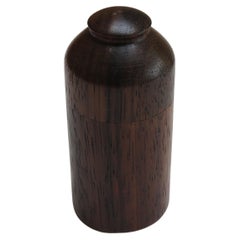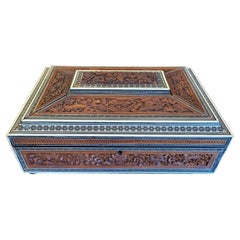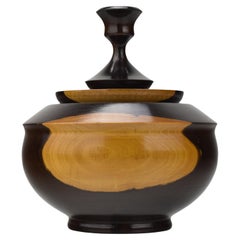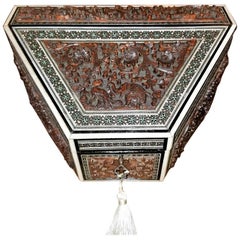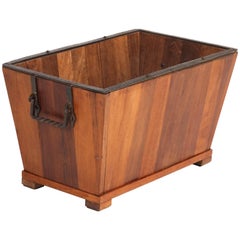Padouk Decorative Boxes
7
to
4
3
7
7
7
1
2
4
1
1
Height
to
Width
to
144
3,550
3,077
1,082
944
4
4
4
2
1
Material: Padouk
Hand turned Padouk Lidded Pot
Located in Stow on the Wold, GB
Wonderful hand produced pot with lid. Turned from Padauk, the colour has mellowed with age, dates from the 1970s.
Green baize to the base. Lid removes. In good over all condition.
Category
Mid-20th Century English Padouk Decorative Boxes
Materials
Padouk
19C Anglo Indian Highly Carved Padouk Wood with Sadeli Mosaic Inlay Sewing Box
Located in Dallas, TX
PRESENTING A LOVELY 19C Anglo Indian Highly Carved Padouk Wood with Sadeli Mosaic Inlay Sewing Box.
Made in Bombay, India, circa 1880.
The box is made of sandalwood with highly carved raised padouk wood panels on all sides, depicting temple scenes, animals and foliage.
The box is in a sarcophagus form.
It is edged in bone (and we can tell it is bone and not ivory, from the color and evidence of capillaries, which are not found in ivory), and banded with Bombay Sadeli mosaic and ebony veneer.
The lid opens to reveal a removable tray with various open compartments and lidded compartments. 5 lidded compartments, 1 unlidded compartment and 8 holders for thimbles, etc
The tray lifts to reveal a blue velvet (original) lined section, for storing jewelry etc, with sections for collars etc.
The inside of the lid has a removable mirror (the mirror is missing on this one but can easily be replaced). Behind the mirror is the original green velvet lining.
It has its original brass carry handles on the sides and sits on 4 silvered button feet (of recent origin).
Some repairs to the exterior and condition issues (priced accordingly), but still a LOVELY COLLECTIBLE box!
These boxes were made by superb Indian craftsmen, specifically for sale to the ruling British elite. These types of boxes, carved padouk and sandalwood, (whilst beautiful and superbly crafted) were of a lesser quality, than the more profusely and intricately mosaic inlay, tortoiseshell and ivory boxes, made for the British ‘Upper Classes’ in the areas of Bombay and Vizagapatam. These type of boxes were much more affordable back in 1880 (and indeed today) and would probably have been bought by mid-level diplomats, civil servants or visitors.
Sewing boxes (in general), were in EVERY Victorian home in Britain in the 19th century and like other boxes etc were ‘status symbols’ of your place in society! The more ornate the box, the more ‘Upper Class’ you were!
SADELI MOSAIC: “Anglo Indian boxes were made in India for the English residents from the early part of the 18th century. They were brought back or sent back to England usually by the people who had commissioned them. From the beginning of the nineteenth century they were imported more commercially, although not in any significant numbers until the middle decades. They were very highly valued, especially the early ones, to the extent that the designs were copied on late 19th and early 20th century tins.
The ancient art of Sadeli Mosaic is said to have been introduced from Shiraz in Persia via Sind to Bombay, a long time before the Anglo Indian boxes were made. It was a technique, which required a high degree of skill and patience. It was executed very lavishly, in that the frequent cuts wasted a great amount of the precious materials used. The workmanship was however more than commensurable to the value of the materials.
Ivory, silver, pewter (or other metals), wood and Horn were cut into faceted rods which were bound together to form geometric patterns. When the glue has set, the rods were sliced in transverse sections. This gave the maker a number of angled circular pieces in the original pattern. Several variations of patterns could be achieved by combining the materials in different ways. The ivory was sometimes dyed green to give an extra color.
The mosaic pieces in a combination of patterns, often separated by ivory, ebony, Horn or silver stringing were used to veneer sandalwood boxes. In the early boxes, which date from the turn of the 18th to the 19th century, there are large panels of mosaic covering tops and sides of boxes. It took incredible skill to cover such large areas without any shakes or wavering of the pattern. The corners and joins on these boxes are impeccably matched.
The makers (reputed to be Persian) of Sadeli mosaic made in the first two decades of the 19th century displayed a total understanding of the qualities of the different materials they used. They combined substances, which can expand and contract according to atmospheric conditions with others, which are hard and unyielding. The result was a sharp definition of the lines and patterns, which made up the whole design.
On the early boxes the designs look deceptively simple. The fact is, they emerged from a culture, which had mastered geometry and understood how to generate a pattern from a set number of points. The patterns are so harmoniously combined that their incredible complexity is not immediately apparent.
The earliest Sadeli boxes...
Category
Late 19th Century Indian Anglo-Indian Antique Padouk Decorative Boxes
Materials
Bone, Padouk, Sandalwood
19c Anglo Indian Highly Carved Padouk and Sandalwood Sarcophagus Sewing Box
Located in Dallas, TX
PRESENTING A VERY NICE 19C Anglo Indian Highly Carved Padouk and Sandalwood Sarcophagus Sewing Box.
Made in Bombay, India circa 1890-1900.
The box case/body is made of sandalwo...
Category
Late 19th Century Indian Anglo-Indian Antique Padouk Decorative Boxes
Materials
Bone, Padouk, Sandalwood
19C Anglo Indian Highly Carved Padouk and Sandalwood Sadeli Mosaic Sarcophagus S
Located in Dallas, TX
PRESENTING A GORGEOUS 19C Anglo Indian Highly Carved Padouk and Sandalwood Sadeli Mosaic Sarcophagus Sewing Box.
Made in Bombay, India circa 1860-80.
Box made of sandalwood with highly carved padouk wood reliefs and panels on all sides.
Edged with bone and ebony veneers and glorious sadeli mosiac, made from tiny pieces of faux ivory, pewter, green semi-precious stone.
The box is in a sarcophagus form with domed lid.
The original brass carry handles are on the sides.
The interior is in great condition and consists of a removeable mirror under the lid portion, with the original red velvet lining behind it.
The base is removeable and contains a number of lidded compartments.
6 of the interior lids on the base, are each inlaid with sadeli mosaic banding. The rest are also carved and chased.
The interior is fully complete with 7 lidded faux ivory/bone, thread canisters with sadeli domes and the original bone thimble.
The box sits on 4 brass ball or bun feet with the original velvet lining on the base.
Some minor repairs and losses, but this box is fully complete. This is ‘rare’ as many of these boxes have not survived in such condition!
Included in the sale are 2 photos that were in the box (under the base tray). Interestingly, one of them is a view of downtown Nassau, New Providence (Bermuda) from the early 20C and stamped on the rear. What a ‘journey’ this piece has made! Made in India … travelled to Bermuda, probably via Britain … back to Ireland (where we bought it) …. then to Texas!
These boxes were made by superb Indian craftsmen, specifically for sale to the ruling British elite. These types of boxes, carved padouk and sandalwood, (whilst beautiful and superbly crafted) were of a lesser quality, than the more profusely and intricately mosaic inlay, tortoiseshell and ivory boxes, made for the British ‘Upper Classes’ in the areas of Bombay and Vizagapatam. These type of boxes were much more affordable back in 1880 (and indeed today) and would probably have been bought by mid-level diplomats, civil servants or visitors.
Sewing boxes (in general), were in EVERY Victorian home in Britain in the 19th Century and like other boxes etc were ‘status symbols’ of your place in society! The more ornate the box, the more ‘Upper Class’ you were!
Of it’s type, this one, is one of the very higher quality one’s, than the norm!
SADELI MOSAIC: “Anglo Indian boxes were made in India for the English residents from the early part of the 18th century. They were brought back or sent back to England usually by the people who had commissioned them. From the beginning of the nineteenth century they were imported more commercially, although not in any significant numbers until the middle decades. They were very highly valued, especially the early ones, to the extent that the designs were copied on late 19th and early 20th century tins.
The ancient art of Sadeli Mosaic is said to have been introduced from Shiraz in Persia via Sind to Bombay, a long time before the Anglo Indian boxes were made. It was a technique, which required a high degree of skill and patience. It was executed very lavishly, in that the frequent cuts wasted a great amount of the precious materials used. The workmanship was however more than commensurable to the value of the materials.
Ivory, silver, pewter (or other metals), wood and horn were cut into faceted rods which were bound together to form geometric patterns. When the glue has set, the rods were sliced in transverse sections. This gave the maker a number of angled circular pieces in the original pattern. Several variations of patterns could be achieved by combining the materials in different ways. The ivory was sometimes dyed green to give an extra color.
The mosaic pieces in a combination of patterns, often separated by ivory, ebony, horn or silver stringing were used to veneer sandalwood boxes. In the early boxes, which date from the turn of the 18th to the 19th century, there are large panels of mosaic covering tops and sides of boxes. It took incredible skill to cover such large areas without any shakes or wavering of the pattern. The corners and joins on these boxes are impeccably matched.
The makers (reputed to be Persian) of Sadeli mosaic made in the first two decades of the 19th century displayed a total understanding of the qualities of the different materials they used. They combined substances, which can expand and contract according to atmospheric conditions with others, which are hard and unyielding. The result was a sharp definition of the lines and patterns, which made up the whole design.
On the early boxes the designs look deceptively simple. The fact is, they emerged from a culture, which had mastered geometry and understood how to generate a pattern from a set number of points. The patterns are so harmoniously combined that their incredible complexity is not immediately apparent.
The earliest Sadeli boxes...
Category
19th Century Indian Anglo-Indian Antique Padouk Decorative Boxes
Materials
Bone, Padouk, Sandalwood
19C Anglo Indian Highly Carved Padouk Sadeli Mosaic Scroll Box of Hindu Gods
Located in Dallas, TX
PRESENTING AN ABSOLUTELY STUNNING AND EXCEPTIONAL 19C Anglo Indian Highly Carved Padouk Sadeli Mosaic Scroll Box of Hindu Gods from circa 1870-80.
The box case is made from sandalwood with highly hand-carved padouk wood reliefs on all sides and banded and edged in fabulous ‘Sadeli Mosaic’, made from faux ivory/bone, ebony, silver, semi-precious green stone, etc., in various geometric patterns.
The carved lid of this box is EXCEPTIONAL!
It is HIGHLY HAND-CARVED and depicts 13 Hindu Gods: Vishnu, Shiva, Harihara, etc., in 9 oval shaped reliefs, surrounded by foliage etc.
The sides and rear have highly carved foliage relief panels.
The lid opens to reveal the original red velvet lining (also on the base) in SUPERB CONDITION throughout.
The QUALITY of the ‘sadeli mosaic’ work is EXCEPTIONAL all over.
It has its key and working lock.
It sits on it’s 4 original brass turned ball feet.
THIS IS A HIGH QUALITY & VERY RARE AND DESIRABLE BOX!
SADELI MOSAIC: “Anglo Indian boxes were made in India for the English residents from the early part of the 18th century. They were brought back or sent back to England usually by the people who had commissioned them. From the beginning of the nineteenth century they were imported more commercially, although not in any significant numbers until the middle decades. They were very highly valued, especially the early ones, to the extent that the designs were copied on late 19th and early 20th century tins.
The ancient art of Sadeli Mosaic is said to have been introduced from Shiraz in Persia via Sind to Bombay, a long time before the Anglo Indian boxes were made. It was a technique, which required a high degree of skill and patience. It was executed very lavishly, in that the frequent cuts wasted a great amount of the precious materials used. The workmanship was however more than commensurable to the value of the materials.
Ivory, silver, pewter (or other metals), wood and horn were cut into faceted rods which were bound together to form geometric patterns. When the glue has set, the rods were sliced in transverse sections. This gave the maker a number of angled circular pieces in the original pattern. Several variations of patterns could be achieved by combining the materials in different ways. The ivory was sometimes dyed green to give an extra color.
The mosaic pieces in a combination of patterns, often separated by ivory, ebony, horn or silver stringing were used to veneer sandalwood boxes. In the early boxes, which date from the turn of the 18th to the 19th century, there are large panels of mosaic covering tops and sides of boxes. It took incredible skill to cover such large areas without any shakes or wavering of the pattern. The corners and joins on these boxes are impeccably matched.
The makers (reputed to be Persian) of Sadeli mosaic made in the first two decades of the 19th century displayed a total understanding of the qualities of the different materials they used. They combined substances, which can expand and contract according to atmospheric conditions with others, which are hard and unyielding. The result was a sharp definition of the lines and patterns, which made up the whole design.
On the early boxes the designs look deceptively simple. The fact is, they emerged from a culture, which had mastered geometry and understood how to generate a pattern from a set number of points. The patterns are so harmoniously combined that their incredible complexity is not immediately apparent.
The earliest Sadeli boxes...
Category
19th Century Indian Anglo-Indian Antique Padouk Decorative Boxes
Materials
Silver
Anglo-Indian Padouk Box
Located in London, GB
An Anglo-Indian brass-mounted padouk and ebony box, Ceylon, second half of the 18th century.
Category
18th Century Antique Padouk Decorative Boxes
Materials
Brass
Early 18th Century Dutch Baroque Box
Located in Kastrup, DK
Rare Dutch baroque box composed of padauk wood with original red lacquer finish, decorated with ivory lacquer with gold outline. Richly adorned with heavy brass (or bronze) decorativ...
Category
Early 18th Century Dutch Baroque Antique Padouk Decorative Boxes
Materials
Brass
Related Items
Anglo Indian Micro Mosaic Inlay Jewelry Box
Located in New York, NY
Exquisitely crafted early 20th century Anglo Indian micro mosaic Sadeli box with gorgeous antique Persian geometric pattern.
The finely detailed box featu...
Category
Early 20th Century Indian Anglo-Indian Padouk Decorative Boxes
Materials
Fruitwood, Bone
Turned Wood Hardwood Lidded Box Chess Figurine Style Mid Century Modern c 1960s
Located in Bad Säckingen, DE
A lovely small turned hardwood lidded box with a chess style shaped finial, made in Europe probably in the 1960s.
Category
20th Century French Mid-Century Modern Padouk Decorative Boxes
Materials
Hardwood, Wood
Jean Gerbino For Vallauris, France, Ceramic Glazed Sage Mosaic Lidded Pot 1960's
By Jean Gerbino
Located in Rothley, Leicestershire
Jean Gerbino for Vallauris, France, ceramic glazed mosaic lidded pot
Sage green, terracotta and cream shades, beautifully crafted
Circa 1960's
Signed Gerbino to base
Height 2.5 inch...
Category
Mid-20th Century French Mid-Century Modern Padouk Decorative Boxes
Materials
Ceramic
Anglo-Indian Style Penwork Box
Located in New York, NY
In the form of a house; the hinged top opening to an open interior. In the spirit of early nineteenth century pinworm on ivory boxes that were highly collected in Regency England.
Category
20th Century English Anglo-Indian Padouk Decorative Boxes
Materials
Ivory, Wood
Erhard & Söhne Art Nouveau Lidded Pot in Patinated Brass
Located in Tilburg, NL
Erhard & Söhne Art Nouveau lidded pot in patinated brass. Germany, early 20th century.
Beautiful art nouveau lidded pot made by Erhard & Söhne in Germany somewhere in the first tw...
Category
Early 20th Century German Art Nouveau Padouk Decorative Boxes
Materials
Brass
Understated Jean Gerbino, Vallauris, France, Ceramic Pale Blue Mosaic Lidded Pot
By Jean Gerbino
Located in Rothley, Leicestershire
Quietly understated elegant Jean Gerbino for Vallauris, France, ceramic glazed pale blue mosaic lidded pot
Classic form and function with signature mosaic from Gerbino
Circa 1960's
S...
Category
Mid-20th Century French Mid-Century Modern Padouk Decorative Boxes
Materials
Ceramic
Anglo Indian Amboyna Campaign Writing Box
Located in Northampton, GB
Brass Bounded
From our Writing Box collection, we are pleased to offer this Anglo Indian Amboyna Campaign Writing Box. The Writing Box of slim re...
Category
Early 19th Century Indian Campaign Antique Padouk Decorative Boxes
Materials
Brass
Mid 20th Century Anglo Indian Carved Wood Jewelry Box Kashmir India
Located in North Hollywood, CA
Vintage hand carved wood jewelry trinket storage box with brass inlaid.
Hand-carved large wooden Anglo-Raj jewelry box. Found in Kashmir, India.
Mi...
Category
Mid-20th Century Indian Anglo-Indian Padouk Decorative Boxes
Materials
Brass
19th Century Anglo Indian Silver and Brass Filigree Dresser Box
Located in Bradenton, FL
19th Century anglo Indian silver and brass filigree inlaid dresser box. This is a gorgeous dresser box, profusely silver inlaid into wood in a stunning geometric pattern. A great pie...
Category
19th Century Indian Anglo-Indian Antique Padouk Decorative Boxes
Materials
Wood
19C Anglo Indian Vizigapatam Stamp Box
Located in Dallas, TX
Presenting an absolutely gorgeous and very rare 19C Anglo Indian Vizigapatam stamp box.
Made in Colonial India (the Time of the Raj) circa 1860.
Prob...
Category
Mid-19th Century Indian Anglo-Indian Antique Padouk Decorative Boxes
Materials
Bone, Shell
1950s Anglo Indian Micro Sadeli Mosaic Inlaid Jewelry Box
Located in North Hollywood, CA
1950s Anglo Indian Micro Sadeli Mosaic Inlaid Jewelry Box.
DIMENSIONS: 7ʺW × 7ʺD × 2.5ʺH.
Indo Persian Moorish style micro mosaic inlaid jewelry box with lid.
Intricate inlaid Anglo ...
Category
Mid-20th Century Indian Moorish Padouk Decorative Boxes
Materials
Fruitwood, Bone
Painted Decorated Anglo Indian Box with Elephants
Located in Palm Beach, FL
A very charming Anglo Indian painted decorated box with elephant, people, peacocks and mystical animal motifs, an outside bracket base and a brass...
Category
Early 20th Century Indian Anglo-Indian Padouk Decorative Boxes
Materials
Hardwood
Previously Available Items
19th Century Anglo-Indian Carved Padouk and Sadeli Stationary Box
Located in Dallas, TX
Lovely Anglo-Indian carved Padouk wood, faux ivory and sadeli mosaic stationary box.
Made in Bombay, India in the 19th century, circa 1880.
The box is constructed of sandalwood...
Category
Late 19th Century Indian Anglo Raj Antique Padouk Decorative Boxes
Materials
Multi-gemstone, Pewter
Dutch Padouk Mid-Century Modern Firewood Box, 1950s
Located in Amsterdam, NL
Stunning and rare Mid-Century Modern firewood box.
Solid padouk with original wrought iron lining and handles.
Striking Dutch design from the 1950s.
In...
Category
1950s Dutch Mid-Century Modern Vintage Padouk Decorative Boxes
Materials
Padouk
19th Century Anglo-Indian Carved Padouk and Sadeli Stationary Box
Located in Dallas, TX
Lovely Anglo-Indian carved Padouk wood, faux ivory and sadeli mosaic stationary box.
Made in Bombay, India in the 19th century, circa 1880.
The box is constructed of sandalwood t...
Category
Late 19th Century Indian Anglo Raj Antique Padouk Decorative Boxes
Materials
Pewter
Anglo-Indian Hardwood Small Chest
Located in San Francisco, CA
A beautifully crafted Anglo-Indian hardwood chest, the interior fitted with compartments, the exterior with two short over one long drawer, all resting on small bracket feet, circa 1...
Category
Mid-19th Century Indian Regency Antique Padouk Decorative Boxes
Materials
Padouk
Recently Viewed
View AllMore Ways To Browse
Silver And Guilloche Enamel Box
Vintage Large Wood Box
Antique Wooden Box Large
Antique Vinaigrette Vinaigrettes
Vinaigrette Antique
Antique Brass Bound Box Boxes
Large Antique Wooden Box Boxes
Large Antique Wooden Box
Glass Casket
Keepsake Boxes
Vintage Walnut Box
Fire Cooking
Small Antique Silver Box
Antique Brass Container
Antique Hat And Hat Box
Large Vintage Wooden Box
Large Vintage Wooden Boxes
Antique Brass Containers
